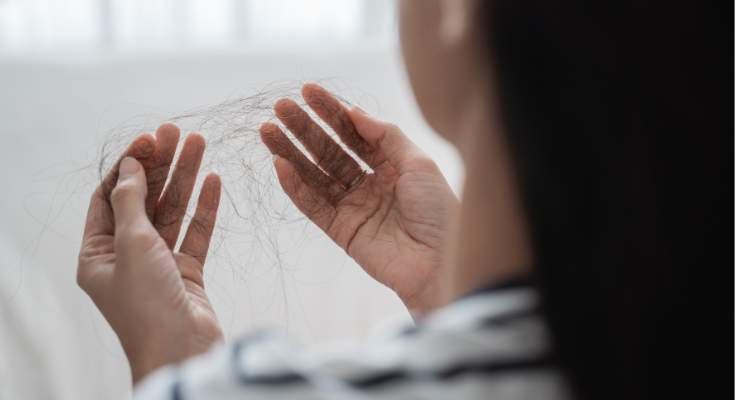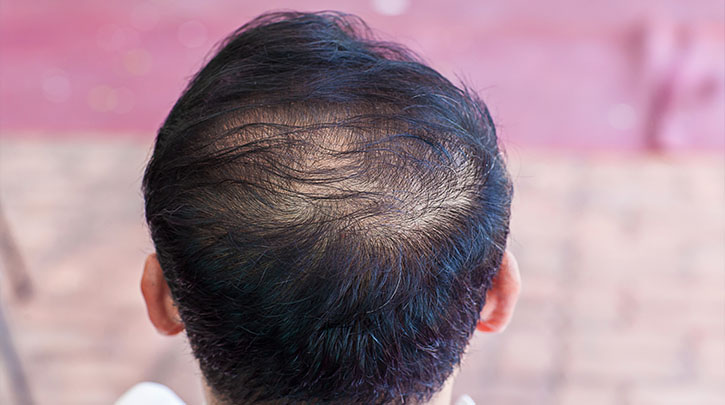
- United States
Get non-surgical solutions for today's top aesthetic concerns with Venus Treatments. Join thousands of satisfied patients worldwide!
- Loading...
- All Regions
Get non-surgical solutions for today's top aesthetic concerns with Venus Treatments. Join thousands of satisfied patients worldwide!

It’s normal to lose about 50-100 strands of hair per day. This might seem like a lot, but the average head has about 100,000 follicles that are constantly producing new strands on a cycle. When this cycle is disrupted, more significant hair loss can occur, resulting in a receding hairline, sparse or bare spots, and an overall thinner appearance to the hair. Many people think that hair loss only affects men. However, it is estimated that more than a third of women will experience noticeable hair loss at some point in life.
Women experience hair loss differently than men do, and female hair loss has different causes and treatments. Women tend to experience overall thinning, rather than balding as men do. Hair loss tends to affect women’s self-esteem and confidence more keenly due to the strong associations between beauty and a full head of hair. It also gets far less attention than male hair loss, even though it is just as common. The good news is that in many cases hair loss can be stabilized with treatment, and it may be reversible. When it’s not, there are still effective cosmetic approaches that can help restore a full, natural-looking head of hair.
If you’re reading this, you probably already have concerns that your hair may be thinning. Here are some of the sign that can help you know for sure:
Hair loss doesn't happen overnight. Strands grow in cycles (a growing phase, transition phase, and resting phase), that occur over a period of about 3 months. That means it can take that long for hair to fall out after a trigger has caused it. It also means you shouldn’t worry too much unless you notice excessive daily hair shedding for longer than 3 months. In that case, there could be an underlying factor that needs to be addressed. Here are some common causes of female hair loss:
Genetics: Does thinning hair run in your family? This type of hair loss is called female-pattern hair loss (FPHL), also known as androgenetic alopecia or androgenic alopecia, and tends to be permanent.
Traction Alopecia: This is caused by damaging the hair through heating, coloring, styling, or frequently wearing hairstyles that pull on the hair. If hair follicles are damaged, the loss can be permanent.
Illness or Stress: Events like losing a lot of weight, surgeries, illness, and having a baby can cause hair loss because of hormone fluctuations. However, this type of hair loss tends to be temporary and the hair will grow back once the body recovers. There are some exceptions, such as when sudden hair loss occurs due to chemotherapy, radiation therapy, and some medications. This type of hair loss can be permanent if the hair follicles are damaged
Vitamin Deficiency: Iron deficiency and a lack of B12 are commonly associated with hair loss in women. It’s important to have a healthy diet to promote healthy hair growth particularly if you're a vegetarian, vegan, or have a history of anemia. Your doctor can do a blood test to check for vitamin deficiencies and suggest supplements, which may stop the hair loss.
Aging: Many women will experience thinning hair as they age, especially around menopause. Hair also becomes finer as part of the aging process, which contributes to the hair looking sparser and thinner. This is due to changing hormones and tends to be permanent.
Treatment for hair loss in women depends on the underlying cause and your aesthetic preferences. Sometimes simply addressing a medical condition prompting hair loss will be enough for the hair to regrow. In other instances, medications like minoxidil help with certain types of hair loss. More treatments will likely be developed in the near future to help regrow or restore lost hair, but these types of treatments tend to work best in cases where the hair loss is temporary. At best, they can only achieve a partial restoration of hair’s former glory.
In cases where the hair loss is permanent due to hair follicles no longer being viable, hair transplantation is the only effective route to hair regrowth. This involves a minimally invasive surgical procedure called Follicular Unit Extraction (FUE) that moves healthy follicles from one area of the scalp to areas where the hair is thinning. The results from FUE are more natural than earlier methods, require no stitches, and leave no visible scarring. Once transplanted, the hair grows normally. NeoGraft® is a trusted name in hair restoration devices, advancing the FUE process even further by being a fully automated system. Automated FUE ensures that only the healthiest follicles are transplanted, through precision micrografts that cause little to no discomfort during the procedure, and require low downtime.
The benefits of a hair restoration procedure using the latest advances in transplantation are considerable. First and foremost, Following a female hair transplant, patients will benefit from a restored, natural-looking hairline that boasts thicker follicles. Recovering lost hair, for most women, also means recovering their self-esteem and confidence in their appearance. Another benefit is the quick recovery time of using the less invasive, automated FUE process. Most people get over the initial tenderness in 2-3 days and return to regular activities in under two weeks with no adverse effects. Lastly, the results of a hair restoration procedure are intended to be long-lasting.
At Venus Concept, we offer cutting-edge hair restoration solutions that utilize advanced technology to achieve discreet, natural-looking results. To find out if you are a good candidate for hair restoration, connect with one of our certified hair restoration providers by using the search field below:
Find a certified Venus Treatments provider near you today who specializes in today’s top aesthetic medical solutions.



Search below to find a provider near you and to learn about our non-surgical aesthetic treatments with ARTAS®, NeoGraft®, Venus Bliss™, Venus Bliss MAX™, Venus Versa™, Venus Legacy™, Venus Velocity™, Venus Viva™ MD, and Venus Glow™.
For more information call: (888) 907-0115 // [email protected] // 4001 SW 47th Ave, Suite 206, Davie, Florida, 33314
REGULATORY CLEARANCES [ More ]
Venus Bliss™ is cleared by the FDA for non-invasive lipolysis of the abdomen and flanks in individuals with a Body Mass Index (BMI) of 30 or less, with the diode laser applicators. The (MP)2 applicator is cleared by the FDA for temporary reduction in the appearance of cellulite.
Venus Versa™ is cleared by the FDA as a multi-application device intended to be used in aesthetic and cosmetic procedures. The SR515 and SR580 applicators are cleared by the FDA for the treatment of benign pigmented epidermal and cutaneous lesions and treatment of benign cutaneous vascular lesions. The HR650/HR650XL and HR690/HR690XL applicators are cleared by the FDA, for the removal of unwanted hair and to effect stable long-term or permanent hair reduction for Fitzpatrick skin types I-IV. The AC Dual applicator is cleared by the FDA for the treatment of acne vulgaris. The DiamondPolar™ and OctiPolar™ applicators on the Venus Versa™ system are cleared by the FDA for non-invasive treatment of moderate to severe facial wrinkles and rhytides on females with Fitzpatrick skin types I-IV. The NanoFractional RF™ applicator is cleared by the FDA for dermatological procedures requiring ablation and resurfacing of the skin.
NeoGraft® is cleared by the FDA with indication for use in suction-assisted follicular extraction and re-implantation. NeoGraft® is an auto-graft system and can be used on both male and female patients.
ARTAS iX™ is cleared by the FDA with indication for use for harvesting hair follicles from the scalp in men diagnosed with androgenic alopecia (male pattern hair loss) who have black or brown straight hair. ARTAS iX™ is intended to assist physicians in identifying and extracting hair follicular units from the scalp during hair transplantation; creating recipient sites; and implanting harvested hair follicles.
Venus Legacy™ is cleared by the FDA for the non-invasive treatment of moderate to severe facial wrinkles and rhytides in females with Fitzpatrick Skin Types I-IV with the OctiPolar™ and DiamondPolar™ applicators, and temporary reduction in the appearance of cellulite with the 4D Body (LB2) and 4D Face (LF2) applicators.
Venus Velocity™ is cleared by the FDA for hair removal, permanent hair reduction (defined as the long-term stable reduction in the number of hairs re-growing when measured at 6, 9 and 12 months after the completion of a treatment regimen), and the treatment of pseudofolliculitis barbae for all Fitzpatrick skin types.
Venus Viva™ is cleared by the FDA for dermatological procedures requiring ablation and resurfacing of the skin. The DiamondPolar™ applicator is cleared by the FDA for the treatment of moderate to severe wrinkles and rhytides in Fitzpatrick skin types I-IV.
Venus Freeze Plus™ is cleared by the FDA for the non-invasive treatment of moderate to severe facial wrinkles and rhytides in Females with Fitzpatrick skin types I-IV.
Venus Heal™ is cleared by the FDA for the relief of minor muscle aches and pain, relief of muscle spasm, and temporary improvement of local blood circulation. These indications enable the treatment of certain soft tissue injuries and conditions.
Venus Freeze™ is cleared by the FDA for the non-invasive treatment of moderate to severe facial wrinkles and rhytides in Females with Fitzpatrick skin types I-IV.
Venus Glow™ is cleared by the FDA as a Class I motorized dermabrasion device. It provides a dermal rejuvenation treatment that works to open up and deep-clean pores. Venus Concept is the exclusive distributor for Venus Glow™.
Venus Swan™ is cleared by the FDA for the non-invasive treatment of moderate to severe facial wrinkles and rhytides.
Copyright © 2025 Venus Concept. All rights reserved.
You are entering our website. For other countries/regions and language options, please click the SELECT A DIFFERENT REGION button below.
SELECT A DIFFERENT REGIONAre you looking to get a treatment? Please visit our patient website to learn more.
Click HereUnsure which aesthetic treatment is right for you? Take this quick and easy quiz to discover treatments that suit your needs.
Get Started